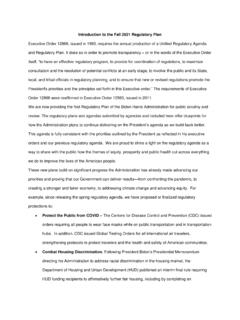Transcription of Emission Factors for Greenhouse Gas Inventories
1 Last Modified: 26 March 2020 Red text indicates an update from the 2018 version of this GWPCH425N2O298 Table 1 Stationary CombustionFuel TypeHeat Content (HHV)CO2 FactorCH4 FactorN2O FactorCO2 FactorCH4 FactorN2O FactormmBtu per short tonkg CO2 per mmBtu g CH4 per mmBtu g N2O per mmBtukg CO2 per short tong CH4 per short tong N2O per shorttonCoal and CokeAnthracite ,60227640 Bituminous ,32527440 Sub-bituminous ,67619028 Lignite ,38915623 Mixed (Commercial Sector) ,01623534 Mixed (Electric Power Sector) ,88521732 Mixed (Industrial Coking) ,46828942 Mixed (Industrial Sector) ,11624636 Coal ,81927340 Other Fuels - SolidMunicipal Solid Coke (Solid) , ,8501, ,407896118 Biomass Fuels - SolidAgricultural ,09633244W ood and W ood ,64012663mmBtu per scfkg CO2 per mmBtu g CH4 per mmBtu g N2O per mmBtukg CO2 per scfg CH4 per scfg N2O per scfNatural GasNatural Fuels - GaseousBlast Furnace Oven Fuels - GaseousLandfill Biomass per gallonkg CO2 per mmBtu g CH4 per mmBtu g N2O per mmBtukg CO2 per gallong CH4 per gallong N2O per gallonPetroleum ProductsAsphalt and Road Fuel Oil No.
2 Fuel Oil No. Fuel Oil No. Gas Jet Petroleum Gases (LPG) (<401 deg F) Oil (>401 deg F) Fuel Oil No. Fuel Oil No. Fuels - LiquidBiodiesel (100%) (100%) Animal Biomass Fuels -Kraft Pulping Liquor, by Wood FurnishNorth American American : # Factors for Greenhouse Gas InventoriesTypically, Greenhouse gas emissions are reported in units of carbon dioxide equivalent (CO2e). Gases are converted to CO2e by multiplying by their global warming potential (GWP). The Emission Factors listed in this document have not been convertedto CO2e. To do so, multiply the emissions by the corresponding GW P listed in the table :Intergovernmental Panel on Climate Change (IPCC), Fourth AssessmentReport (AR4), 2007. See the source note to Table 11 for further Register EPA; 40 CFR Part 98; e-CFR, June 13, 2017 (see link below). Table C-1, Table C-2, Table : Emission Factors are per unit of heat content using higher heating values (HHV).
3 If heat content is available from the fuel supplier, it is preferable to use that value. If not, default heat contents are text indicates an updatefrom the 2018 version of this Factors for Greenhouse Gas InventoriesLast Modified: 26 March 2020 Table 2 Mobile Combustion CO2 Fuel Typekg CO2 per unitUnitAviation (100%) Natural Gas (CNG) (100%) Jet Natural Gas (LNG) Petroleum Gases (LPG) Fuel : # 3 Mobile Combustion CH4 and N2O for On-Road Gasoline VehiclesVehicle TypeYearCH4 Factor(g / mile)N2O Factor(g / mile)Gasoline Passenger Light-Duty (Vans, Pickup Trucks, SUVs) Heavy-Duty Vehicles< : EPA (2020) Inventory of Greenhouse Gas emissions and Sinks: 1990-2018. All values are calculated from Tables A-107 through MotorcyclesFederal Register EPA; 40 CFR Part 98; e-CFR, June 13, 2017 (see link below). Table : The factor was developed based on the CO2 factor for Natural Gas factor and LNG fuel density from Model, Argonne National Laboratory.
4 This represents a methodology change from previous 2 of 6 Red text indicates an updatefrom the 2018 version of this Factors for Greenhouse Gas InventoriesLast Modified: 26 March 2020 Table 4 Mobile Combustion CH4 and N2O for On-Road Diesel and Alternative Fuel VehiclesVehicle TypeFuel TypeVehicle YearCH4 Factor(g / mile)N2O Factor(g / mile) :EPA (2020) Inventory of Greenhouse Gas emissions and Sinks: 1990-2018. All values are calculated from Tables A-110 through 5 Mobile Combustion CH4 and N2O for Non-Road VehiclesVehicle TypeFuel TypeCH4 Factor(g / gallon)N2O Factor(g / gallon)Residual Fuel (2 stroke) (4 stroke) (2 stroke) (4 stroke) (2 stroke) (4 stroke) (2 stroke) (4 stroke) (2 stroke) (4 stroke) (2 stroke) (4 stroke) (2 stroke) (4 stroke) :EPA (2020) Inventory of Greenhouse Gas emissions and Sinks: 1990-2018. All values are calculated from Tables A-114 through :A Includes equipment, such as tractors and combines, as well as fuel consumption from trucks that are used off-road in Includes equipment, such as cranes, dumpers, and excavators, as well as fuel consumption from trucks that are used off-road in CarsLight-Duty TrucksDieselDieselDieselLight-Duty CarsLight-Duty TrucksMedium-Duty TrucksHeavy-Duty TrucksBusesShips and BoatsAircraftMedium- and Heavy-Duty VehiclesAgricultural EquipmentAAgricultural Offroad TrucksConstruction/Mining EquipmentBConstruction/Mining Offroad TrucksLawn and Garden EquipmentAirport EquipmentIndustrial/Commercial EquipmentLogging EquipmentRailroad EquipmentRecreational EquipmentPage 3 of 6 Red text indicates an updatefrom the 2018 version of this Factors for Greenhouse Gas InventoriesLast Modified.
5 26 March 2020 Table 6 ElectricityeGRID SubregionCO2 FactorCH4 FactorN2O FactorCO2 FactorCH4 FactorN2O Factor(lb / MWh)(lb / MWh)(lb / MWh)(lb / MWh)(lb / MWh)(lb / MWh)AKGD (ASCC Alaska Grid)1, , (ASCC Miscellaneous) , (W ECC Southwest)1, , (W ECC California) (ERCOT All) , (FRCC All) , (HICC Miscellaneous)1, , (HICC Oahu)1, , (MRO East)1, , (MRO W est)1, , E (NPCC New England) (W ECC Northwest) , (NPCC NYC/W estchester) , (NPCC Long Island)1, , (NPCC Upstate NY) (RFC East) , (RFC Michigan)1, , (RFC W est)1, , (W ECC Rockies)1, , (SPP North)1, , (SPP South)1, , (SERC Mississippi Valley) , (SERC Midwest)1, , (SERC South)1, , (SERC Tennessee Valley)1, , (SERC Virginia/Carolina) , , 7 Steam and HeatCO2 Factor(kg / mmBtu)CH4 Factor(g / mmBtu)N2O Factor(g / mmBtu)Steam and : Emission Factors are per mmBtu of steam or heat purchased. These Factors assume natural gas fuel is used to generate steam or heat at 80 percent thermal 8 Scope 3 Category 4: Upstream Transportation and Distribution and Category 9: Downstream Transportation and DistributionVehicle TypeCO2 Factor(kg / unit)CH4 Factor(g / unit)N2O Factor(g / unit)UnitsMedium- and Heavy-Duty and Heavy-Duty aterborne Factors are intended for use in the distance-based method defined in the Scope 3 Calculation Guidance.
6 If fuel data are available, then the fuel-based method should be used, with Factors from Tables 2 through :CO2, CH4, and N2O emissions data for road vehicles are from Table 2-13 of the Greenhouse Gas emissions and Sinks: 1990 2018 (Feb. 2020).Vehicle-miles and passenger-miles data for road vehicles are from Table VM-1 of the Federal Highway Administration Highway Statistics emissions data for non-road vehicles are based on Table A-124 of the Greenhouse Gas emissions and Sinks: 1990 2018, which are distributed into CO2, CH4, and N2O emissions based on fuel/vehicle Emission ton-mile data for non-road vehicles are from Table 1-50 of the Bureau of Transportation Statistics, National Transportation Statistics for 2019 (Data based on 2017).Source:EPA eGRID2018, March 2020 Note: Total output Emission Factors can be used as default Factors for estimating GHG emissions from electricity use when developing a carbon footprint or emissions inventory.
7 Annual non-baseload outputemission Factors should not be used for those purposes, but can be used to estimate GHG emissions reductions from reductions in electricity Output Emission FactorsNon-Baseload Emission FactorsScope 3 Emission FactorsScope 3 Emission Factors provided below are aligned with the Greenhouse Gas Protocol Technical Guidance for Calculating Scope 3 emissions , version (Scope 3 Calculation Guidance). W here applicable, the specific calculation method is referenced. Refer to theScope 3 Calculation Guidance for more information ( ).Notes:Vehicle-mile Factors are appropriate to use when the entire vehicle is dedicated to transporting the reporting company's product. Ton-mile Factors are appropriate when the vehicle is shared with products from other car: includes passenger cars, minivans, SUVs, and small pickup trucks (vehicles with wheelbase less than 121 inches).
8 B Light-duty truck: includes full-size pickup trucks, full-size vans, and extended-length SUVs (vehicles with wheelbase greater than 121 inches).CWaterborne Craft: updates due to a methodology 4 of 6 Red text indicates an updatefrom the 2018 version of this Factors for Greenhouse Gas InventoriesLast Modified: 26 March 2020 Table 9 Scope 3 Category 5: Waste Generated in Operations and Category 12: End-of-Life Treatment of Sold ProductsNew TableMaterialRecycledALandfilledBCombust edCCompostedDAnaerobically Digested(Dry Digestate withCuring)Anaerobically Digested(Wet Digestate withCuring)Aluminum W Waste (non-meat) Waste (meat only) and Paper (general) Paper (primarily residential) Paper (primarily from offices) MSW (municipal solid waste) Electronic ood 10 Vehicle TypeCO2 Factor(kg / unit)CH4 Factor(g / unit)N2O Factor(g / unit)UnitsPassenger Rail - Northeast Rail - Other Rail - National Rail Rail ( Subway, Tram) Travel - Short Haul (< 300 miles) Travel - Medium Haul (>= 300 miles,< 2300 miles) Travel - Long Haul (>= 2300 miles) :These Factors do not include any avoided emissions impact from any of the disposal methods.
9 All the Factors presented here include transportation emissions , which are optional in the Scope 3 Calculation Guidance, with an assumed average distance traveled to theprocessing facility. AR4 GWPs are used to convert all waste Emission Factors into Recycling emissions include transport to recycling facility and sorting of recycled materials at material recovery Landfilling emissions include transport to landfill, equipment use at landfill and fugitive landfill CH4 emissions . Landfill CH4 is based on typical landfill gas collection practices and average landfill moisture Combustion emissions include transport to combustion facility and combustion-related non-biogenic CO2 and N2OD Composting emissions include transport to composting facility, equipment use at composting facility and CH4 and N2O emissions during :EPA, Office of Resource Conservation and Recovery (February 2016) Documentation for Greenhouse Gas Emission and Energy Factors used in the Waste Reduction Model (WARM).
10 Factors from tables provided in the Management Practices Chapters andBackground Chapters. WARM Version 15. Additional data provided by EPA, WARM-15 Background :APassenger car: includes passenger cars, minivans, SUVs, and small pickup trucks (vehicles with wheelbase less than 121 inches).B Light-duty truck: includes full-size pickup trucks, full-size vans, and extended-length SUVs (vehicles with wheelbase greater than 121 inches).C Intercity rail: Amtrak long-distance rail between major cities. Northeast Corridor extends from Boston to Washington Other Routes are all routes outside the Northeast Commuter rail: rail service between a central city and adjacent suburbs (also called regional rail or suburban rail)E Transit rail: rail typically within an urban center, such as subways, elevated railways, metropolitan railways (metro), streetcars, trolley cars, and Factors are intended for use in the distance-based method defined in the Scope 3 Calculation Guidance.


















